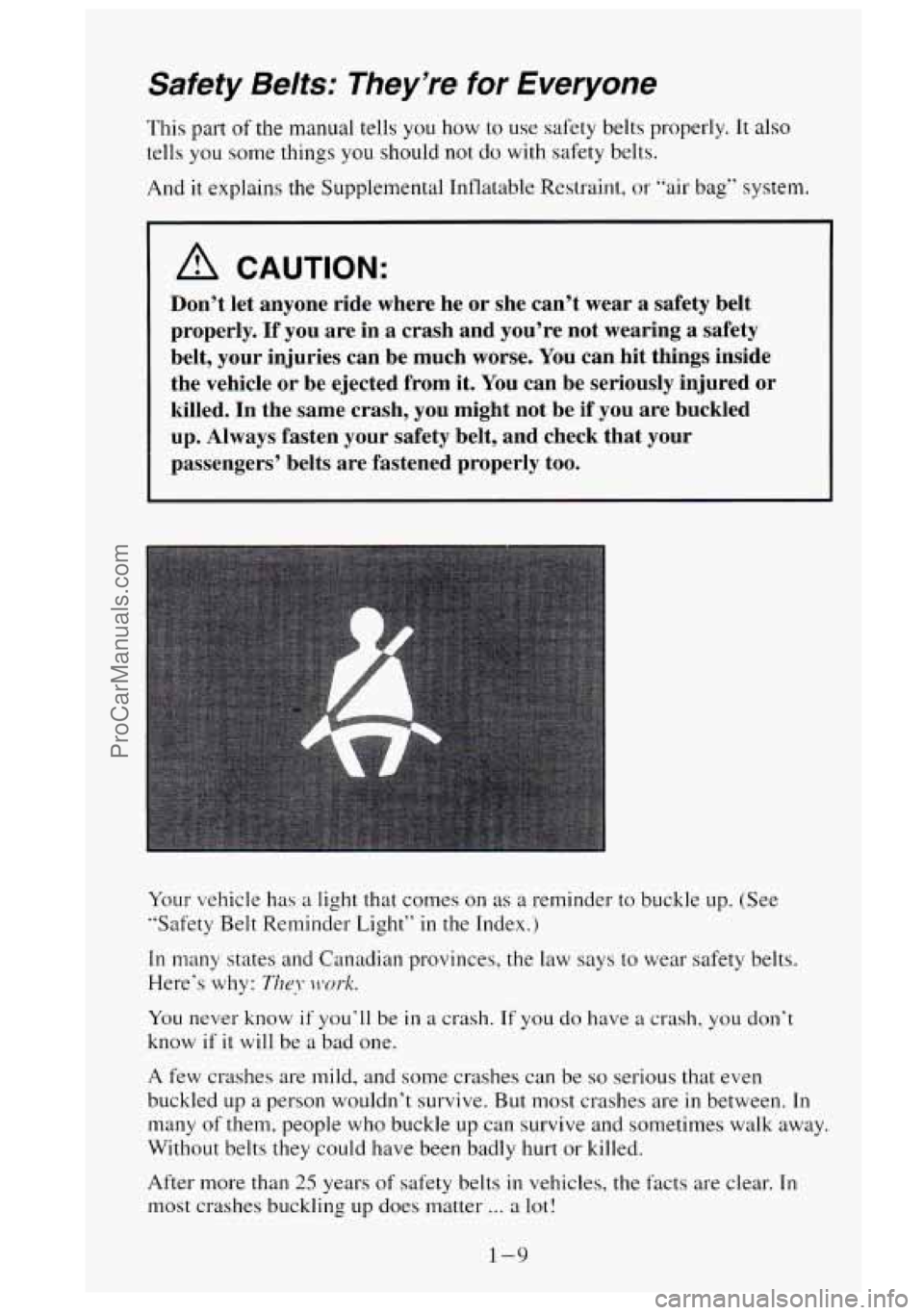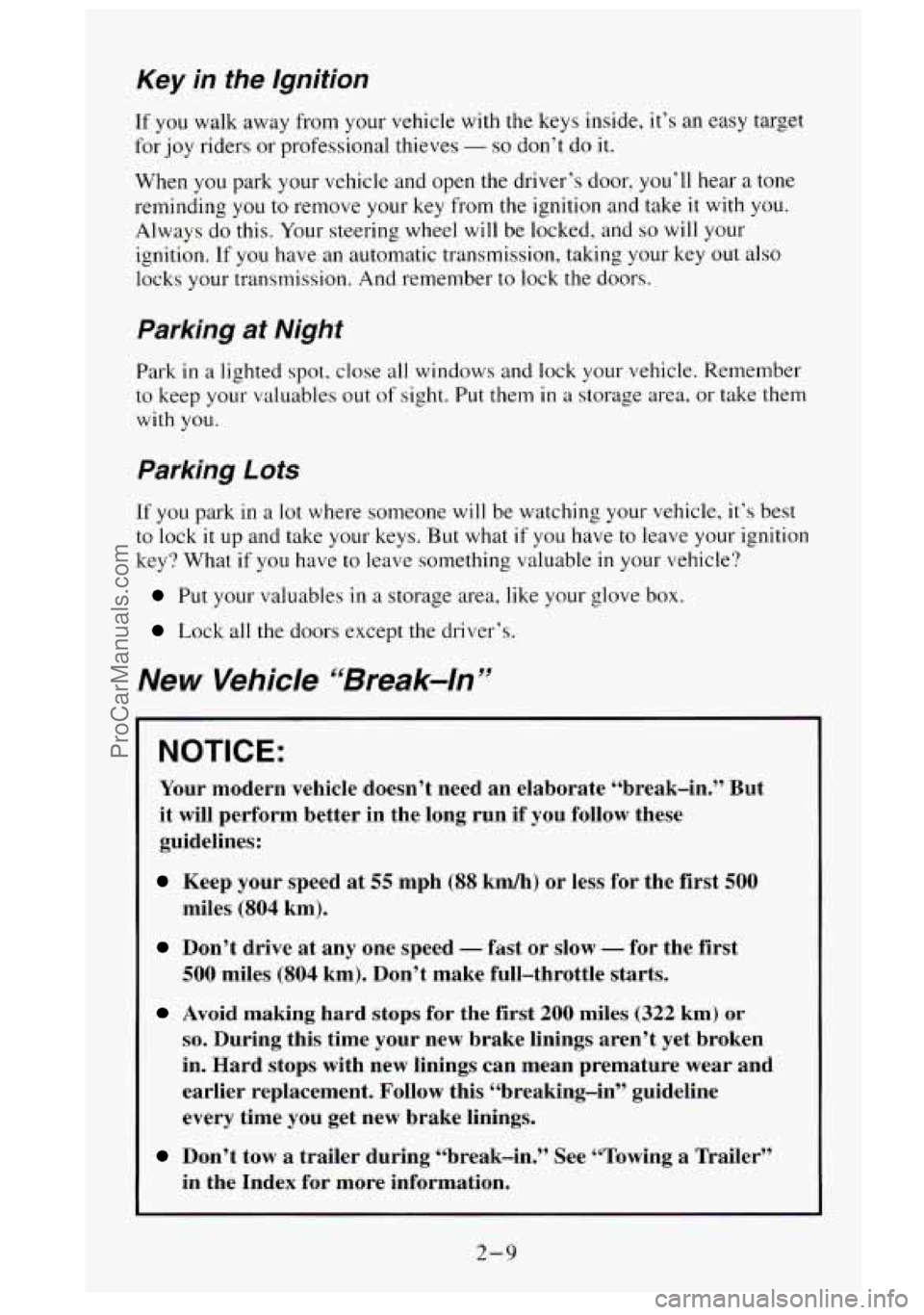Page 13 of 488
These symbols are important for you and your passengers whenever your
vehicle is driven:
~~ ~
Fasten Safety Door Lock/Unlock
Belts
These symbols have to do with your lights:
Master Lighting
Switch Turn
Signal
Direction
Fog Lights Daytime
Running Lights
A
I
Hazard Warning
Flasher Headlight
High Beam
vii
ProCarManuals.com
Page 14 of 488
These symbols are on some of your controls:
uu
Windshield Wiper Windshield
Washer
I I
Windshield Defroster
Ventilating Fan
These symbols are used on warning and indicator lights:
Engine Coolant
Temperature
~~
Battery Charging
System
BRAKE
Brake
ANTI-
LOCK
4 Wheel
Anti-Lock
I 1
Rear Window
Defogger
Fuel
Parking Brake
Release
Engine Oil
Pressure
SHIFT
Shift Lighf
Vlll . ..
ProCarManuals.com
Page 15 of 488
Here are some other symbols you may see:
El fuse
1
le Lighter I I I Horn Speaker
Hood Release
ix
ProCarManuals.com
Page 25 of 488

Safety Belts: They’re for Everyone
This part of the manual tells you how to use safety belts properly. It also
tells you some things you should not do with safety belts.
And it explains the Supplemental Inflatable Restraint, or “air bag” system.
A CAUTION:
Don’t let anyone ride where he or she can’t wear a safety belt
properly.
If you are in a crash and you’re not wearing a safety
belt, your injuries can be much worse. You can hit things inside
the vehicle or be ejected from it. You can be seriously injured or
killed. In the same crash, you might not be if you are buckled
up. Always fasten your safety belt, and check that your
passengers’ belts are fastened properly too.
YOLE vehicle has a light that comes on as a reminder to buckle up. (See
“Safety Belt Reminder Light” in the Index.)
In many states and Canadian provinces, the law says to wear safety belts.
Here‘s why:
They 1.zvl-k.
You never know if you’ll be in a crash. If you do have a crash, you don’t
know
if it will be a bad one.
A few crashes are mild, and some crashes can be so serious that even
buckled up
a person wouldn’t survive. But most crashes are in between. In
many of them, people who buckle up can survive and sometimes walk away.
Without belts they could have been badly hurt or killed.
After more than
25 years of safety belts in vehicles, the facts are clear. In
most crashes buckling up does matter
... a lot!
1-9
ProCarManuals.com
Page 36 of 488
A CAUTION:
Air bags inflate with great force, faster than the blink of an eye.
If you’re too close to an inflating air bag, it could seriously
injure you. Safety belts help keep you in position for an air bag
inflation in a crash. Always wear your safety belt, even with
an
air bag, and sit as far back as you can while still maintaining
control of your vehicle.
There is an air bag readiness light on the instrument panel, which shows
AIR BAG. The system checks the air bag‘s electrical system for
malfunctions.
The light tells you if there is an electrical problem. See “Air
Bag Readiness Light” in the index for more information.
How the Air Bag System Works
1-20
ProCarManuals.com
Page 66 of 488
Tailgate
You can open the
tailgate by lifting up
on its handle while
pulling the tailgate
toward you.
To shut the tailgate, firmly push it away from you into the latch.
When you put the tailgate back up, pull it back toward you, to be sure that it
latches securely.
Tailgate Removal
The tailgate on your vehicle can be removed to allow for different loading
situations. Although the tailgate can be removed without assistance, you
may want someone to assist you with the removal to avoid possible finish
damage.
To remove the tailgate:
Raise the tailgate slightly and
release both
retaining cable
clips. To release
the cable clips,
lift the cable so it
points straight out
and push the
cable clips forward.
2-4
7 F
ProCarManuals.com
Page 67 of 488
0 With the tailgate
at a slight upward
angle,
pull back
on the tailgate at
the right edge and
then move the
tailgate to the
right,
to release
the left edge.
Reverse
the above procedure to re-install. Make sure the tailgate is secure.
Door Locks
A CAUTION:
Unlocked doors can be dangerous.
Passengers
- especially children - can easily open the doors
and fall out. When a door is locked, the inside handle won’t open
it.
Outsiders can easily enter through an unlocked door when you
slow down or stop your vehicle.
This may not be
so obvious: You increase the chance of being
thrown out
of the vehicle in a crash if the doors aren’t locked.
Wear safety belts properly, lock your doors, and
you will be far
better
off whenever you drive your vehicle.
2-5
ProCarManuals.com
Page 71 of 488

Key in the Ignition
If you walk away from your vehicle with the keys inside, it’s an easy target
for joy riders or professional thieves
- so don’t do it.
When you park your vehicle and open the driver’s door, you‘ll hear a tone
reminding
you to remove your key from the ignition and take it with you.
Always do this.
Your steering wheel will be locked, and so will your
ignition. If you have
an automatic transmission, taking your key out also
locks your transmission. And remember to lock the doors.
Parking at Night
Park in a lighted spot, close all windows and lock your vehicle. Remember
to keep
your valuables out of sight. Put them in a storage area, or take them
with
you.
Parking Lots
If you park in a lot where someone will be watching your vehicle, it‘s best
to lock
it up and take your keys. But what if you have to leave your ignition
key? What if
you have to leave something valuable in your vehicle?
Put your valuables in a storage area, like your glove box.
Lock all the doors except the driver’s.
New Vehicle “Break-In ”
NOTICE:
Your modern vehicle doesn’t need an elaborate “break-in.” But
it will perform better in the long run if you follow these
guidelines:
Keep your speed at 55 mph (88 km/h) or less for the first 500
miles (804 km).
Don’t drive at any one speed - fast or slow - for the first
500 miles
(804 km). Don’t make full-throttle starts.
Avoid making hard stops for the first 200 miles (322 km) or
so. During this time your new brake linings aren’t yet broken
in. Hard stops with new linings can mean premature wear and
earlier replacement. Follow this “breaking-in” guideline
every time you get new brake linings.
Don’t tow a trailer during “break-in.” See “Towing a Trailer”
in the Index
for more information.
2-9
ProCarManuals.com